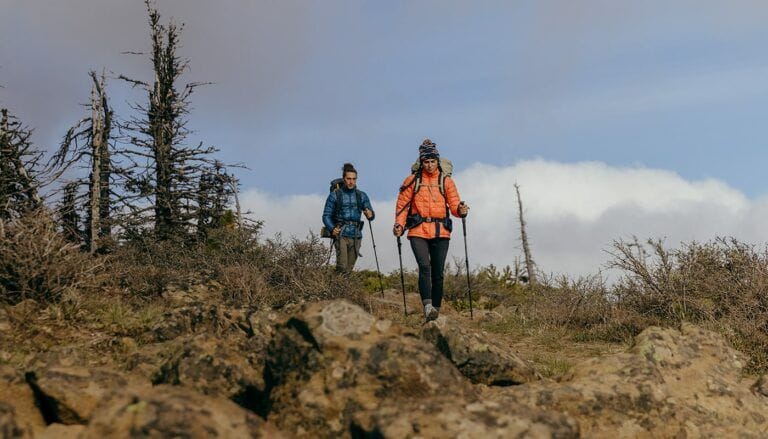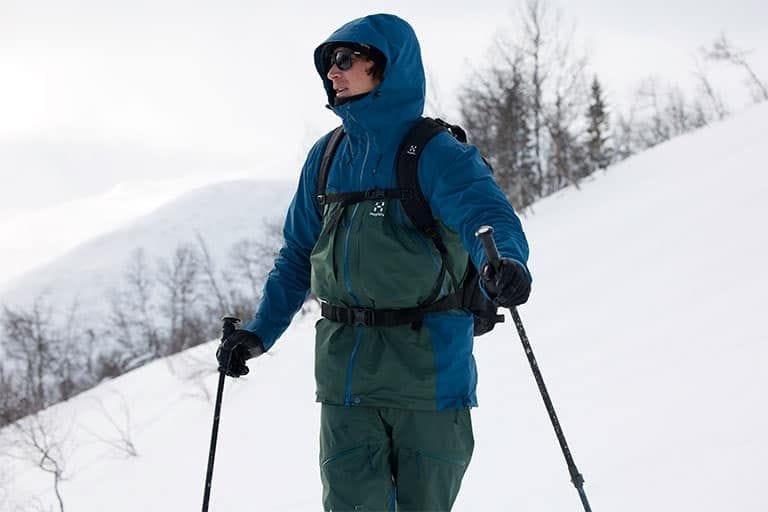
The post What Running Shoes Should I Buy? appeared first on Altitude Sports.
]]>Whether you’re chasing a new personal best or simply trying to stay active, choosing the right running shoes is one of the most important steps you can take—literally. The perfect pair doesn’t just feel good underfoot; it supports your stride, absorbs shock, and helps prevent injuries over time.
From rocky trails to busy city sidewalks, today’s running shoes are engineered for performance. Whether you need heel cushioning, ample arch support, or stability devices to smooth out your gait cycle, modern designs offer the features that match your running style and the surfaces you run on.
But with so many options on the market, how do you find the right pair for you?
This guide breaks it all down—foot type, running style, terrain, and even the best features to look for in a new pair. Whether you shop online or step into a store, we’ll help you make sense of what matters most in a pair of running shoes.
Table of Contents
Which Type of Runner Are You?
Before you can find the right running shoes, you need to figure out what kind of runner you are. Your goals, habits, and terrain choices will shape what kind of shoe will deliver the most comfortable ride—and help you avoid injuries along the way.
Casual Runners & Fitness Walkers
If you’re running a few times a week for general fitness or stress relief, focus on lightweight shoes that offer ample cushioning and good shock absorption. You’ll want something that feels great straight out of the box and doesn’t overcomplicate things. A neutral running shoe is often the best starting point here—especially if your foot shape doesn’t show signs of overpronation or supination.
Distance Runners & Marathon Training
Training for a half or full marathon? You need a pair of running shoes that can go the distance—literally. Prioritize energy return, heel cushioning, and a shoe that fits properly even after your feet begin to swell on long runs. Depending on your stride, you might opt for a zero drop shoe (if you’re a midfoot striker) or a shoe with a higher heel-to-toe drop for more support during heel strikes. Check out the best running shoes for long distance.
Pro Tip: Rotate two pairs of shoes during training to extend their life and reduce injury risk.
Trail Runners & Hybrid Adventurers
Love to mix trail running with the occasional hike? You’ll need trail running shoes that handle uneven terrain, provide good grip, and protect your feet from roots, rocks, and sudden weather changes. Look for ankle support, a tough outsole, and durable upper materials that can take a beating.
Racing & Speed Work
Training for your next PB? Whether you’re doing tempo runs or lining up for a 5K, a lightweight, responsive shoe with a snappy feel will serve you best. Think minimalist shoes with less cushioning, lower heel drop, and maximum ground feel—perfect for midfoot strike runners and speed demons.
Types of Terrain
Where you run is just as important as how you run. Your running surface dictates the grip, cushioning, and durability your shoes need. Choosing a pair tailored to your usual terrain ensures a comfortable ride, better performance, and fewer injuries.
Paved Roads
If most of your running takes place on sidewalks, pavement, or packed gravel, you’ll want road running shoes. These shoes are designed to handle repetitive impact on flat surfaces, with lightweight construction, moderate heel cushioning, and responsive midsoles for energy return. Look for a comfortable fit, reliable shock absorption, and ample cushioning to protect your joints from hard landings.
Trails and Technical Terrain
Trail runners need footwear that grips and protects. If you’re navigating uneven terrain, roots, rocks, or mud, you’ll need trail running shoes with aggressive lugs, reinforced uppers, and enhanced ankle support. A rock plate in the midsole protects your foot from sharp objects, while a wider toe box gives your foot room to splay on impact.
Snow, Ice & Winter Conditions
Winter runners face an entirely different challenge: traction and warmth. In icy or snowy conditions, opt for winter running shoes with water-resistant uppers, thermal insulation, and grippy outsoles that prevent slipping. Many models offer a zero drop shoe design for better control and natural foot movement on slick ground.
Choosing Your Running Shoes for Your Foot Type
Finding the right pair of running shoes starts with understanding your feet. Every runner has a unique gait, foot shape, and level of pronation, all of which influence how a shoe feels and performs over time. Choose wrong, and you risk discomfort, inefficiency—or worse, injury.
Let’s walk through the basics to help you match your foot type to the best running shoe.
Know Your Foot Type
Your foot shape can usually be categorized in one of three ways:
- Neutral Arch: This is the most biomechanically efficient foot type. The foot rolls inward slightly (neutral pronation) to absorb shock. Most neutral runners do well with neutral running shoes that offer cushioning and minimal motion control.
- Flat Feet (Low Arch): This foot type often leads to overpronation, where the foot rolls inward excessively. Runners with flat feet benefit from stability shoes or motion control shoes that help correct this gait cycle and offer arch support.
- High Arches: High-arched runners often underpronate (supinate), meaning the foot rolls outward and doesn’t absorb impact well. They need lightweight shoes with ample cushioning and flexibility to help with shock absorption.
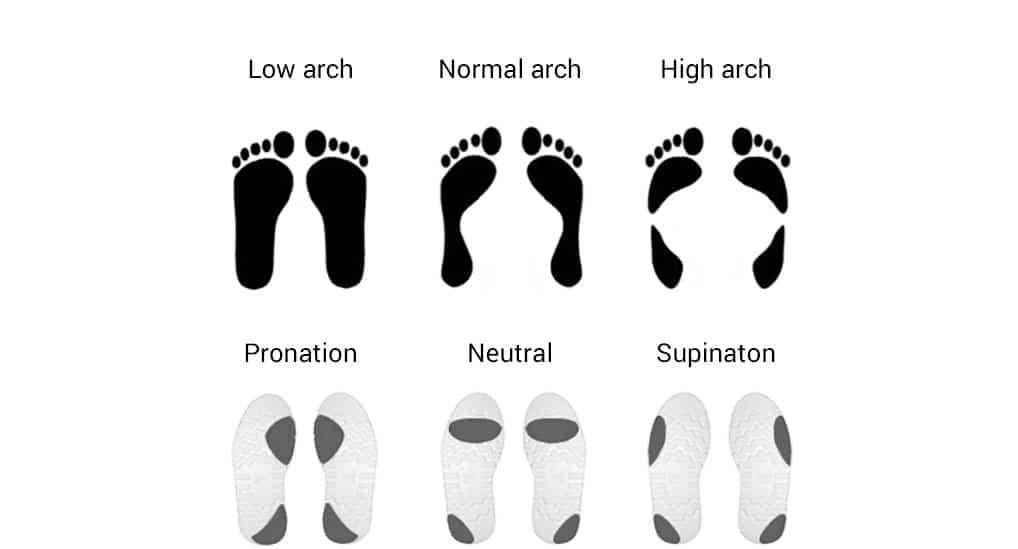
Pronation and Wear Patterns
Your gait cycle directly affects how your foot strikes the ground. The right shoe design can support the ankle, align your stride, and reduce strain on the knees and hips. If you’ve worn down a few pairs of running shoes, look at the outsole wear:
- Neutral pronation: Wear is centralized at the ball and heel.
- Overpronation: Wear is heavier along the inner edge.
- Supination: Wear shows mostly on the outer edge.
Key Features to Look for in Running Shoes
Once you’ve identified your running goals, terrain, and foot type, it’s time to get down into the nitty-gritty specs. Remember, the right pair of running shoes should offer more than just a comfortable ride—they should support your gait cycle, absorb shock, and help prevent injuries. Here’s what to focus on when buying shoes.
1. Cushioning & Support
Cushioning is the unsung hero of injury prevention. It reduces impact on your joints and delivers that sought-after energy return with every stride. Some runners have a personal preference for a more cushioned shoe for long distances, while others opt for lightweight shoes with a firmer feel for short, fast runs.
- Maximalist shoes: Offer ample cushioning and are ideal for longer efforts, recovery runs, or runners seeking extra comfort.
- Minimalist shoes: Designed for those who want a zero drop shoe or a more natural, barefoot shoes feel. These shoes encourage a midfoot strike and less heel dependency.
2. Heel-to-Toe Drop
The heel drop—or “offset”—is the height difference between the heel and the forefoot. It affects how your foot moves on impact. Pro Tip: Transition slowly if you’re moving to a zero drop shoe to avoid strain on your Achilles tendon.
- Higher drops (8–12mm) promote heel strikes, which can work for beginners or those needing more support.
- Lower drops (0–6mm) suit midfoot strikers and runners working on form or efficiency.
3. Upper Materials
The upper (everything above the sole) affects how the shoe fits and feels. It influences how the shoe feels as your foot moves mile after mile.
- Look for breathable mesh if you want cool airflow.
- Choose waterproof uppers for wet weather runs.
- For structure and ankle support, look for TPU overlays that reinforce the ankle collar and heel counter.
4. Midsole & Outsole
This is where the magic (and the science) happens. Basically, the outsole should match your running surface—flexible and grippy for trails, smooth and responsive for pavement.
- The midsole houses your cushioning system—often made of EVA foam—and sometimes layered for extra stability or shock absorption.
- Some shoes include stability devices like medial posts or torsion bars to reduce overpronation.
- Trail shoes may include a shank or rock plate for protection on uneven terrain.
5. Brand Specializations
Some brands cater to specific needs—like support, speed, or long-distance training—while others offer all-around options. Check out our Best Running Shoe Brands guide for an in-depth breakdown.
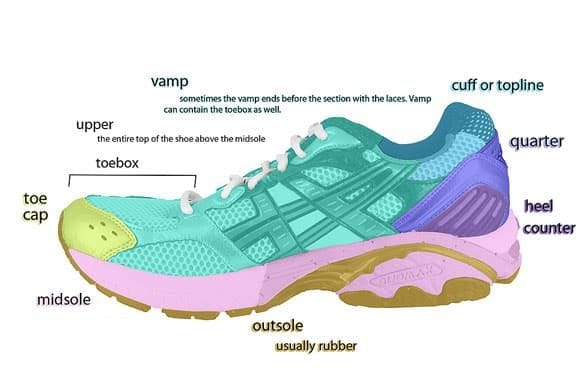
Expert Tips for Choosing the Right Running Shoes
Choosing the right running shoes isn’t just about brand or colour. It’s about matching your shoes to your body, goals, and running style. Whether you’re new to the sport or logging weekly mileage, here’s how to make the smartest choice.
1. Beginners vs. Experienced Runners
If you’re just starting out:
Prioritize comfort and injury prevention. Look for ample cushioning, neutral running shoes with moderate support, and a wider toe box to accommodate natural toe splay. Lightweight shoes can be a bonus, but shouldn’t come at the cost of stability or ankle support.
If you’ve been running for a while:
You might benefit from rotating multiple pairs based on terrain, distance, and training intensity. A minimalist shoe could be great for short recovery runs, while a more cushioned shoe may be better for long runs. As your training evolves, so should your footwear. Pay attention to how each shoe interacts with your gait cycle, heel strike, or midfoot strike—especially if you’re pushing for speed or distance.
2. Replace Your Running Shoes Regularly
Even the best running shoes wear down. As midsoles lose their shock absorption and energy return, your risk of injury skyrockets. Small aches and joint soreness can be early signs that your shoes are no longer doing their job.
Pro Tip: Replace your shoes every 500–800 km (300–500 miles), depending on your stride, weight, running surface, and the shoe itself.
If the heel cushioning feels flat or the comfortable ride you once had starts to feel stiff or uneven, chances are it’s time for new running shoes.
3. Match the Shoe to the Surface
The running surface you train on should influence your shoe choice:
- Road running shoes are designed for paved surfaces, prioritizing light weight, smooth heel-to-toe drop, and reliable cushioning.
- Trail running shoes offer better traction, ankle support, and foot protection for uneven terrain, rocks, and roots.
- Winter running shoes are weather-resistant and built with grippy outsoles for snow and ice.
4. Avoid Common Mistakes
Buying the wrong shoes is one of the quickest ways to derail your progress—especially if you’re clocking regular mileage. Here are some of the biggest pitfalls to avoid.
- Choosing style over fit: A sleek silhouette or trending colour won’t matter if the shoe doesn’t fit properly for your foot type or running style.
- Skipping a proper fit test: Always try both shoes on. On average, your right foot tends to be slightly larger than your left. So, fit for the largest foot and make sure there’s a thumb’s width of space beyond your longest toe.
- Not paying attention to the almighty toe box: The toe box shouldn’t be too narrow—you want room for your toes to splay naturally. Look for a wider toe box if you experience pressure points, or need more wiggle room. You can also try different lacing techniques to relieve pressure or improve lockdown around the midfoot.
- Forgetting that your shoe sizing varies: Try shoes on later in the day when your feet are slightly swollen to get a true fit to your max shoe length. And remember that feet change—especially with age, training volume, or pregnancy. If you’re not sure, have your feet measured by a professional.
- Ignoring your running gait or pronation pattern: A mismatch between your gait cycle and shoe type can lead to discomfort or injury. Understanding whether you overpronate, supinate, or fall in the neutral zone is crucial.
- Sticking to the same brand by default: Shoe technologies evolve quickly. What worked for you two years ago might not be the best fit now. Try different brands, and consider how innovations in heel cushioning, heel drop, and energy return could serve you better.
- Wearing shoes past their lifespan: Old shoes may still look fine but often lose the structural support your body needs. This is especially important if you’re training for longer distances or working through high-volume running workouts.
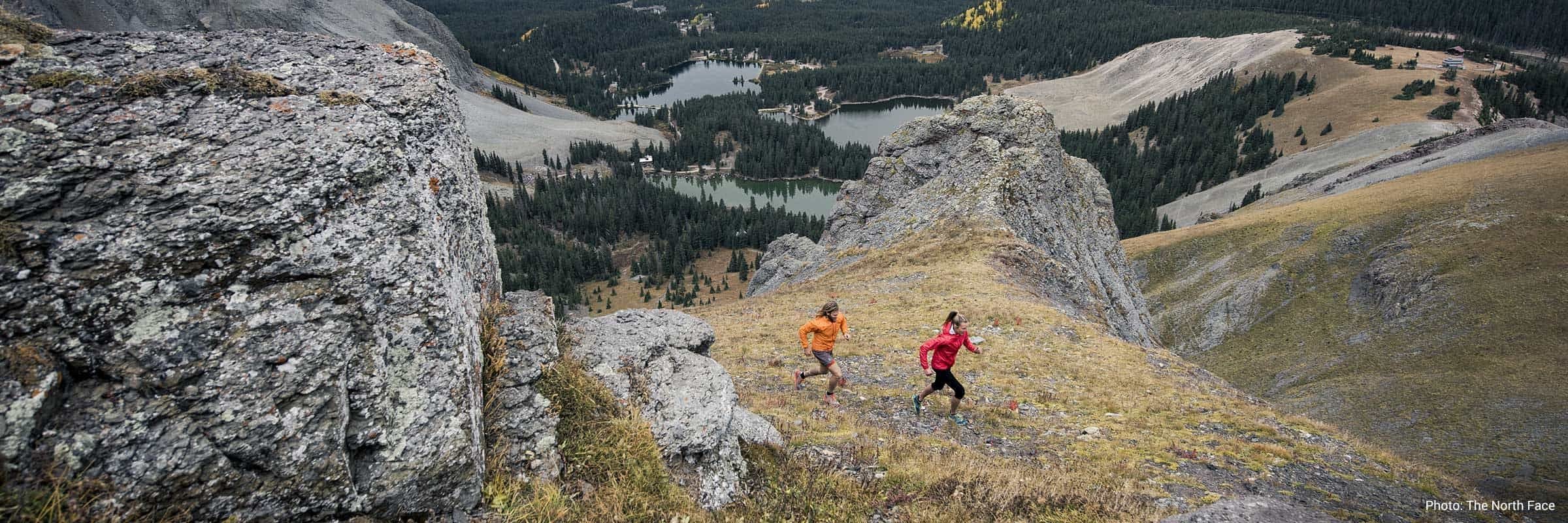
FAQ: Buying the Right Running Shoes
How do I know what running shoes I need?
Start with your running goals and terrain. Are you running on roads, trails, or a bit of both? Then assess your foot type and gait. The best running shoes will match your arch height, pronation style, and how your foot strikes the ground. Still unsure? Visit a running store for a gait analysis.
How do I determine my foot type for running shoes?
You can learn a lot by checking the wear pattern on an old pair of shoes or doing a simple wet footprint test.
- Neutral arch: Even pressure across the foot
- Flat feet (overpronation): Inner edge wear; look for stability shoes
- High arches (supination): Outer edge wear; go for more cushioned shoes
How do I choose running shoes as a beginner?
Look for a comfortable ride, breathable upper, and heel cushioning that supports your stride. You don’t need the most advanced model—just one that fits properly and suits your running surface. Also, consider a neutral running shoe unless you know you overpronate.
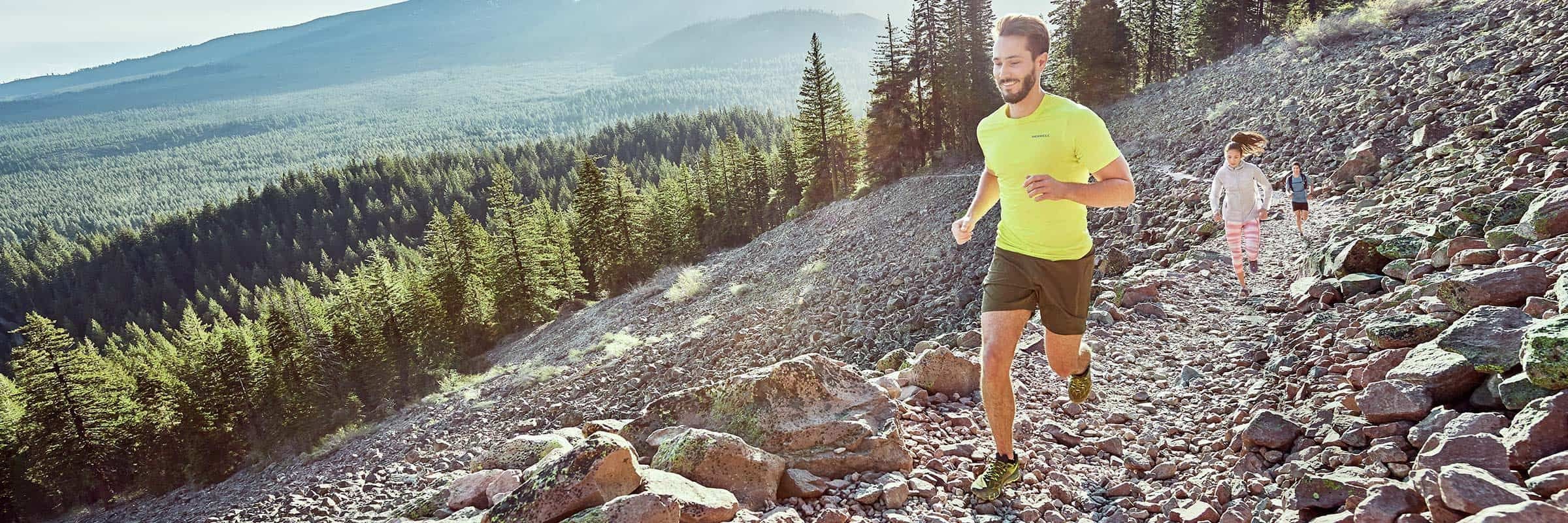
Conclusion
The right running shoes aren’t just about comfort—they’re your foundation for better performance, injury prevention, and long-term motivation. Whether you’re logging your first kilometre or chasing a new PR, your shoes should work with your body, your terrain, and your goals.
Remember:
- Match your shoes to your running surface and distance
- Pay attention to fit, cushioning, and support, as this makes all the difference
- Don’t ignore signs of wear—replacing worn shoes is part of staying injury-free
The perfect pair is out there waiting for you—and once you find it, every run will get a little bit easier and a lot more fun.
The post What Running Shoes Should I Buy? appeared first on Altitude Sports.
]]>The post How to Choose the Right Hiking Footwear appeared first on Altitude Sports.
]]>Choosing the right hiking footwear is more than a matter of preference—it’s the key to enjoying your hike. The right pair can boost your performance, keep your feet comfortable over long distances, and most importantly, help prevent injuries. Whether you’re heading out for a short trail walk or a multi-day mountain trek, getting your footwear right is the first step toward a great day outdoors.
Table of Contents
Which Type of Hiker Are You?
Before you choose your footwear, think about the kind of hiker you are—or want to become. A casual weekend walker doesn’t need the same boots as someone tackling back-to-back summits. Here’s how your hiking style can influence your choice:
- Beginner hikers may prefer flexible, lightweight shoes that don’t feel overly technical or restrictive.
- Day hikers and backpackers need footwear with more support and cushioning to handle varied terrain and longer distances.
- Trail runners want nimble, responsive shoes with grippy outsoles and snug fits for quick movements.
- Alpine trekkers and mountaineers rely on heavy-duty boots that offer serious traction, protection, and insulation.
Knowing where you fit helps narrow down what you need on your feet.
Types of Footwear for Hiking
There are four main types of footwear when it comes to hiking:
- Hiking shoes
- Hiking boots
- Mountaineering boots
- Trail runners
The differences between these four categories will vary based on the boot’s height, durability, protection, and support.
1. Hiking Shoes
Hiking shoes (women’s, men’s) are going to be the most lightweight and flexible option compared to hiking boots and mountaineering boots especially in hot weather conditions. Although these characteristics are appealing because heavy boots can cause leg and foot fatigue more quickly, hiking shoes don’t often offer as much support as hiking boots or mountaineering boots.
WHO SHOULD BUY HIKING SHOES?
- If you are going to be sticking to day hikes and shorter hikes where the routes are well-maintained with minimal obstacles to tackle and are not carrying a lot of weight.
- If you are an avid hiker you have most likely built up the strength in the muscles you use most when hiking (feet, ankles, calves, and legs) so a pair of hiking shoes would be suitable as you are not relying on your shoes to provide a lot of support.
- For beginner hikers who have not yet gained the strength in these hiking muscles or someone who is prone to rolling their ankles, hiking shoes may not be the best choice for you. You will want footwear with more support and protection such as a hiking boot.
ShoeChaussure
BagSac
TentTente
- Lorem ipsum dolor<\/li>
- Lorem ipsum dolor<\/li>
- Lorem ipsum dolor<\/li><\/ul>","_id":"7bdda7f"},{"feature":"
- Lorem ipsum dolor<\/li>
- Lorem ipsum dolor<\/li>
- Lorem ipsum dolor<\/li><\/ul>","_id":"af6008a"}],"single_product_id":null,"cta_1_url":null,"cta_2_url":null,"credit":null,"limit":4,"collection_link":"https:\/\/www.altitude-sports.com\/collections\/footwear-men-hiking-shoes"}
2. Hiking Boots
Hiking boots or backpacking boots (women’s, men’s) are best suited for backpacking around the globe or trekking through the bush. They’re built to withstand multiple days of back-to-back use while carrying heavy loads but also function as fantastic day hiking boots. These boots are going to be durable, dependable, taller than hiking shoes and a bit stiffer, too. Generally, hiking boots are able to withstand all kinds of terrain and weather conditions.
WHO SHOULD BUY HIKING BOOTS?
- You will travel through rain and shallow creeks one day and snow and puddles of mud the next.
- You want boots that offer more protection than hiking boots.
- You have multi-day trips planned and will be hiking with a heavy backpack.
Often, hiking boots will include features such as a toe cap and heel groove that are compatible with crampons or snowshoes so you really can travel on all kinds of terrain.
These boots will generally require a bit of break-in time and may not fit like a slipper out of the box. With this break-in period, it is suggested to give yourself at least 2 weeks to get a feel for your new boots so you don’t end up with bloody, blister-covered feet 2 days into your 8-day adventure.
ShoeChaussure
BagSac
TentTente
- Lorem ipsum dolor<\/li>
- Lorem ipsum dolor<\/li>
- Lorem ipsum dolor<\/li><\/ul>","_id":"7bdda7f"},{"feature":"
- Lorem ipsum dolor<\/li>
- Lorem ipsum dolor<\/li>
- Lorem ipsum dolor<\/li><\/ul>","_id":"af6008a"}],"single_product_id":null,"cta_1_url":null,"cta_2_url":null,"credit":null,"limit":4,"collection_link":"https:\/\/www.altitude-sports.com\/collections\/footwear-men-hiking-boots"}
3. Mountaineering Boots
For those embarking on burlier expeditions, mountaineering boots are ideal for bearing heavy loads, provide good traction for slippery and snowy terrain, and are ideal for proper ankle stability out in the backcountry. These boots are designed to be worn in alpine environments where extreme conditions may be present.
MOUNTAINEERING SHOES WILL BE:
- Taller for optimal ankle support and protection.
- Stiffer (midsoles) to accommodate crampons should they be necessary.
- Equipped with waterproof shells to keep out the elements like rain and slush.
- Insulated to keep feet warm when the conditions turn for the worse.
- Equipped with removable liners so they can be aired out after long distance hiking.
ShoeChaussure
BagSac
TentTente
- Lorem ipsum dolor<\/li>
- Lorem ipsum dolor<\/li>
- Lorem ipsum dolor<\/li><\/ul>","_id":"a9ff378"},{"feature":"
- Lorem ipsum dolor<\/li>
- Lorem ipsum dolor<\/li>
- Lorem ipsum dolor<\/li><\/ul>","_id":"f8f247a"}],"single_product_id":null,"cta_1_url":null,"cta_2_url":null,"credit":null,"limit":null,"collection_link":null}
4. Trail Running Shoes
Trail running shoes, or trail runners (men’s, women’s), are rugged shoes that provide more traction than the average running shoe and are lighter than either a hiking shoe or hiking boot. This type of shoe is typically wider near the toes (called the “toe box”), making it the ideal choice for preventing blisters, improving coordination, and making room for swollen feet.
With all that in mind, they’re not ideal for soggy terrain or intense alpine conditions due to the lack of ankle protection. Trail running shoes are best paired with lightweight gaiters to prevent loose rocks from getting kicked up into the heel of your shoe. Check out our favourite trail running shoes here.
WHO SHOULD BUY TRAIL RUNNING SHOES:
- Daily, long-distance, or competitive trail runners.
- Day and multi-day runners, as well as thru-hikers who don’t need ankle support and prefer a lightweight, packable shoe.
Those who like to hike and run; wearing trail runners on the road is possible but may be overkill due to the increased traction and low-profile sole designed for bumpy terrain. That said, there has been a recent uptick in the release of trail running shoes with varying degrees of sole support, so it’s definitely worth looking into!
ShoeChaussure
BagSac
TentTente
Footwear for Different Terrains
Your gear should match the ground you’re walking on. Different terrains demand different features from your footwear. Here’s a quick breakdown:
- Rocky terrain – Choose stiff-soled boots with solid toe protection and excellent traction. Your feet will thank you on scrambly descents.
- Muddy trails – Go for shoes or boots with aggressive tread and waterproof uppers to keep you steady and dry.
- Snowy or icy conditions – Prioritize insulation, high ankles for snow protection, and outsoles that work with microspikes or crampons. Though we don’t cover this type of footwear here, feel free to check out our top picks for winter hiking boots.
- Wet or marshy zones – Look for fast-drying, waterproof footwear with drainage and moisture-wicking linings.
- Well-groomed trails – Lightweight hiking shoes or trail runners are ideal for comfort and breathability.
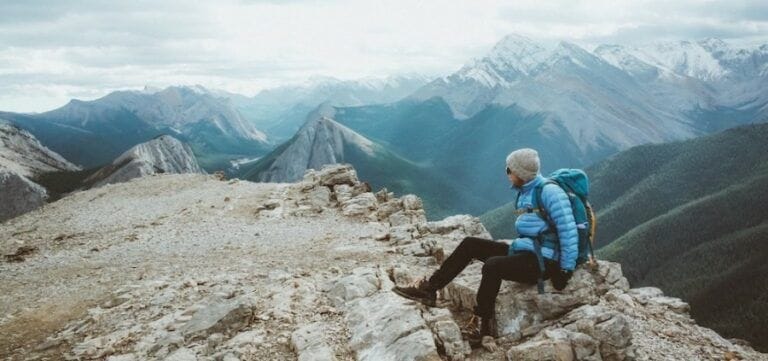
CHOOSING THE RIGHT HIKING FOOTWEAR
The details of your next adventure will help you select the right hiking footwear. Graded switchbacks with dirt, twigs, and the occasional rock isn’t the time to sport a pair of heavy-duty mountaineering boots—save them for your next alpine expedition. Instead, a pair of low cut hiking shoes or hiking boots with ankle support will surely do the trick, even with a heavy pack on your back. You’ll especially appreciate the breathability of non-GORE TEX footwear.
Grippy, wide, and lightweight trail runners are perfect for those who run and hike fast on rugged terrain. Even the hiker who keeps the weight of their backpack to a minimum may find much benefit in trail running shoes.
Now that you have a clear idea of how to dress your feet for the next big outing, check out the latest and greatest hiking gear on the market today. Heck—why not pair ‘em with a new backpack, too?
HIKING FOOTWEAR MATERIALS
Like a running shoe, a hiking boot is made up of a variety of materials that will impact its weight, breathability, durability, and waterproofness. The hiking boot upper (the piece of material that is either sewn or glued to the midsole of the boot) can come in multiple different materials which are listed below.
1. Leather
FULL-GRAIN LEATHER
Full-grain leather is the most durable of the seven materials. It is abrasion-resistant and water-resistant which is why it is used most often for hiking boots. This material is designed for durable boots that will be carrying heavy loads while traveling on rugged terrain for multi-day excursions.
SPLIT-GRAIN LEATHER
Split-grain leather is commonly used for lightweight, breathable shoes and will often be paired with nylon or nylon mesh to enhance its lightweight and breathable qualities. Although usually more cost-friendly, split-grain leather is not as resistant to water and abrasion like full-grain leather is. For this, some split-grain leather boots will be equipped with waterproof liners to make up for the lack of water resistance.
NUBUCK LEATHER
Nubuck leather is the same material as full-grain leather except that it has been buffed to give the appearance of suede. Like full-grain leather, nubuck leather will also be water and abrasion resistant but unlike full-grain leather, it will also be slightly flexible.
2. Synthetic leather or fabric
Synthetic materials used to make hiking boots include polyester, nylon, and synthetic leather. Although synthetic materials may show wear sooner than a durable leather boot, they are more lightweight, dry faster, and don’t take as long to break in. These materials generally cost less than leather and are more commonly used for hiking shoes rather than hiking boots.
3. Waterproof
Hiking boots that are labeled as waterproof will most often be manufactured with waterproof breathable membranes such as Gore-Tex which is also commonly used for other outdoor gear like jackets.
4. Vegan-friendly
For the vegans of the world, there are even some hiking boots that are made with vegan-friendly materials. Vegan boots are harder to come across and can sometimes be mislabeled. Some boots that are labeled as “made with vegan materials” are made with a variety of glues that are not guaranteed to be vegan-friendly.
5. Insulation
Some mountaineering boots that are meant for use in colder climates like hiking on snow and glaciers are equipped with synthetic insulation. These boots are made to keep your feet warm so your time spent in the mountains isn’t cut short due to cold feet.
FEATURES OF A HIKING BOOT OR SHOE
Hiking boots are similar to running shoes when it comes to their anatomy. There are many features including rands, durable soles (midsoles and outsoles), support components, and a boot’s crampon compatibility that influence the overall product.
1. Rand
If you’re planning to go exploring somewhere where there is a high chance that you will be exposed to wet terrains like shallow creeks or sloshy, mud puddles, a pair of boots that are equipped with rands may be for you. This feature will offer extra protection from water when the terrain is extra muddy and wet as well as protect the boot’s leather from abrasion when the terrain becomes rocky and rough.
A hiking boot rand can be found on waterproof/breathable boots. This is the wide, rubber wrap that is found around where the upper meets the midsole although sometimes the rand only encircles the toe of the boot.
2. Crampon-Compatible
While shopping for your next pair of hiking boots, keep in mind if you wish to use crampons for any excursions especially if you plan to go off trail. Some crampons, such as the strap-on type, will be compatible with nearly all types of boots. Others, like the step-in or hybrid type, will only work for certain boots. If you’re going to be needing crampons for a future expedition, it is best to figure out which style of crampon you will be searching for and base your boot shopping on that knowledge.
Some crampons are only compatible with a boot that has a groove on both the toe and heel of the boot. Other crampon styles will require a boot with a much more rigid sole, so make certain you are sure of the equipment you will be needing in order to have compatible equipment!
Should you wish to learn more about the other types of technical features of a hiking boot, you can read more about insoles, outsoles, and support components in our guide to pick the perfect running shoe.
HOW SHOULD HIKING SHOES AND BOOTS FIT?
The fit of your hiking boot will play the biggest role in the selection process. If you’re going to be spending multiple hours or even multiple days on your feet, you want to be as comfortable as you possibly can.
To ensure you pick the right fitting boot, here are a few good tips to keep in mind:
- A comfortable pair of hiking boots should feel snug when laced up. You want your foot to feel secure but not so tight that you can’t wiggle your toes.
- When you’re trying on hiking boots, it’s best to go at the end of the day because our feet swell throughout the day. If you try on a pair of hiking boots at the start of the day it may feel very different compared to at the end of the day once your foot has swelled slightly. Going at the end of the day can avoid the chance of purchasing a pair of boots that are, in fact, too small.
- If you have a pair of hiking socks that you plan on wearing during your trip, bring them along while shopping. Trying on boots with thicker hiking socks will give you a better idea of the fit. Guessing if that little extra space will suffice once you have a thicker pair of socks on isn’t the best route. *Be prepared. Bring your hiking socks and any insoles or wear orthotics you will be using on your trip so you can ensure you are purchasing the right boot.
- Whether you’re trying the boots on in a shop or have just received a new package in the mail, walk around in the boots and get a feel for them. If there is a set of stairs nearby or an inclined surface, walk up and down a few times; stand with your feet together and bend your knees.
- If you feel any discomfort at all while wearing the boots around, they are not the right boots. Any little bump or pinch may create serious blisters and hot spots and can potentially ruin a trip by cutting it short due to sore feet.
- When shopping online for hiking boots, it may be best to go with a brand you are familiar with so you are aware of the foot length and width of that brand.
Breaking in New Hiking Boots
A good rule to live by is to never—ever!—take brand-new boots straight onto the trail. Breaking in hiking boots takes time and a bit of patience, but it makes all the difference in comfort and performance.
Start by wearing them around the house or on short errands. Once they start to mold to your feet, take them on increasingly longer walks and, eventually, local hikes. Pair them with the socks you plan to hike in, and make sure the laces and insoles are adjusted properly.
Taking this step helps reduce the risk of blisters, hotspots, and pressure points when you’re finally out on the trail. Trust us—your feet will thank you.
FAQ
Q: What type of footwear is best for hiking?
The type of footwear best for hiking largely depends on where you’re hiking and your personal preferences for comfort and support.
Here’s a quick breakdown: Hefty mountaineering boots are great for extreme backcountry conditions. Trail running shoes are lightweight and grippy—perfect for going fast and carrying light loads on your back. Hiking shoes and hiking boots are best for your average hiking trip, the former being a lighter, less supportive option than the latter.
Q: Do hiking boots make a difference?
Hiking boots make a huge difference. Not only do they provide excellent support for long and short backpacking trips alike (especially when carrying a heavy backpack), but they also protect your feet from rugged trail conditions and the ever-changing elements.
Q: Is it OK to wear running shoes for hiking?
Yes. It is completely okay to wear running shoes (men’s, women’s) on a hike. They’re best suited for dry, predictable terrain; however, they do not provide ankle support, lack good grip in wet and muddy terrain, and are unlikely to include features that protect your feet against the elements, such as a GORE TEX outer.
YOU’VE PICKED YOUR FOOTWEAR, NOW WHAT?
Once you’ve settled on a snazzy, new pair of hiking boots, get out there and explore!
As mentioned earlier, some boots may require a break-in period, if that’s the case, wear them around your house (before they’ve gotten all dirty obviously), take the dog for a walk, or go exploring in the woods near your house. Your hiking boots are going to be your closest partner for your next adventure so get to know them and get comfortable in them. Now it’s finally time to check out the best hiking boots and hiking shoes for your next adventure!
The post How to Choose the Right Hiking Footwear appeared first on Altitude Sports.
]]>The post 6 Must-Know Glamping Sites Near Vancouver appeared first on Altitude Sports.
]]>Glamping lets you experience all the benefits of sleeping outside—without the grit and grime that comes with tent camping. Here are six destinations in British Columbia where you can unwind in style.
Camping is a rite of passage in BC. There’s something life-affirming about spending time in the great outdoors: waking up to the call of birds, stargazing at the mysterious night sky, blissfully staring for hours at a crackling fire. Tucked between BC’s most dramatic snow-capped peaks and its endless wave-battered Pacific coastline are thousands of provincial parks, even more backcountry sites, and miles of beach- and lake-front where you can pitch a tent. But what about those times when you don’t feel like roughing it? Enter, glamping.
What’s Glamping?
At its simplest, glamping is anything that elevates your everyday camp experience from rustic to (more) regal. It could be as easy as packing an extra comforter, some solar-powered string lights, and ingredients for that new s’mores recipe you found. At the other end, you’ll find ultra-luxe touches like full-sized beds, bathrooms with running water, and on-site spa facilities. More often than not, glamping involves staying in a unique structure—here in BC, you’ll find everything from a geodesic dome perched on the quiet shores of an ocean inlet to a solar-powered off-grid cabin tucked deep in the larch tree-covered hills of its interior. Whether you’re easing into nature for the first time or simply upgrading your usual camping setup, there’s a glamping site for you.
How to Plan for a Glamping Trip
First, you’ll want to book early—there are fewer glamping sites than campgrounds and popular spots tend to fill up fast. Check the weather forecast and make sure to pack accordingly (think: do you need extra books and games for bad weather days?). Even at the most luxurious glamping site, you’ll want to spend some time exploring the natural surroundings—layers are key to making sure you’re comfy and dry when spending time outside. And while glamping celebrates indulgence (not excess), consider booking an eco-conscious stay that balances luxury with sustainability. After all, what’s more sophisticated than practicing responsible recreation?
Glamping Gear Essentials
Like car camping, glamping lets you bring non-essential items along for the ride. Half the joy of glamping is designing your own custom way to experience the outdoors. Budding chefs can pack portable stoves and BBQs and cook up an elaborate camp feast. Coffee snobs can dial in their morning brew with a coffee maker and your favourite mug. Prefer something stronger? Pack your cocktail shaker and camp cooler for happy hour outdoors. Soft rugs, extra blankets, comfy slippers, and hammocks make downtime at camp even more inviting.
ShoeChaussure
BagSac
TentTente
Top 6 Glamping Sites to Get You Started
Wildpod Tofino | Oceanfront Pods

With Wildpod’s geodesic waterfront domes, you’ll have a front-row seat to Tofino’s rugged coastline—crashing waves, shifting tides, and endless ocean horizons included. This glamping site features six pods that are located within walking distance of the stores, coffee shops, and restaurants that line Tofino’s downtown. Each pod comes with its own ensuite bathroom and hot shower, a queen size bed, propane fireplace, kitchenette, and a cedar deck for taking in the view—although you could just as easily admire the view from bed thanks to the dome’s five-metre-wide panoramic window.
Why we love it: For its walkable location, Ocean Friendly certification, and million-dollar view.
Nearby attractions: Wander the rain-soaked trails of Pacific Rim National Park, try cold water surfing, dine at world-class restaurants, or pamper yourself even further with a session at Tofino Resort & Marina’s floating, wood-fired sauna.
Smith Lake Farm | Lakeside Glamping

This 90-acre working farm offers guests lakefront living and access to Vancouver Island’s spectacular coastline. Nestled in the Comox Valley, Smith Lake Farm is an agritourism retreat that brings together experiences like apiary tours and beekeeping courses with glamping. During the day you can tour the farm (and pick up local honey), sweat it out in the barrel sauna, or SUP across the lake. At night, retreat to one of six Lotus Belle glamping tents, each with its own queen- or king-size bed, private outdoor toilet, and propane firepit. A no-frills kitchen tent is outfitted with a two-burner camp stove, utensils, and basin for washing dishes.
Why we love it: For its peaceful lakeside setting, wood-fired sauna, and farm-fresh breakfast options.
Nearby attractions: Explore farmers’ markets in the Comox Valley, hike into the alpine in Strathcona Provincial Park, or mountain bike the extensive trail network in nearby Cumberland.
Woods on Pender | Airstream Glamping

Swap canvas tents for the retro cool of a vintage Airstream trailer at Woods on Pender. This Gulf Island retreat delivers a stylish escape with plenty of access to nature. There are nine Airstream trailers to choose from, all varying in size and amenities. Some have attached bunkies—offering a little more leg room and space to sleep. Others are compact but functional. (There’s even an Airstream spa where you can book in for a massage.) Each Airstream comes with an outdoor hot tub or shower, hammock, and firepit—perfect for stargazing—while the on-site restaurant and coffee shop means you’re never far from a good meal or cup of coffee.
Why we love it: For its Gulf Island charm, photogenic backdrop, and dedication to all things Airstream.
Nearby attractions: Sample the small-batch ciders of Twin Island, wander Pender Island’s quiet beaches, or rent a kayak and look for orcas and seals.
Out There, Off Leash | Private Glamping Retreat

Out There, Off Leash offers the ultimate glamping escape: your very own private island. This all-inclusive eco-resort is located only 10 minutes by boat from Egmont on BC’s Sunshine Coast, but it feels miles away thanks to the island’s secluded setting. The resort can host up to six guests in three distinct, yet equally stunning accommodations: a treehouse (with incredible views of forest and ocean), waterfront tent, or a boho-style yurt with a wraparound sun deck. There are kayaks, SUPs, and snorkel gear available to use, while meals, snacks, and other provisions are taken care of—all you need to bring is yourself and a cleared schedule.
Why we love it: For its choice of beds, no-hassle experience, and laid-back vibes.
Nearby attractions: Check out the tidal rapids of Skookumchuck Narrows or the turquoise waters of Ruby Lake, hike Mount Daniel in Pender Harbour, or rent jet skis and venture up Jervis Inlet.
Tin Poppy | A Vintage Off-Grid Cabin

Tin Poppy blends vintage charm with eco-friendly design for a unique glamping experience. This off-grid, solar-powered retreat sits on 160 secluded acres overlooking the Shuswap River and North Okanagan Valley and is home to four cabins. Its namesake cabin is partially built from a restored 32-foot vintage caravan, featuring wood walls and corrugated steel siding. While it can sleep a crowd (thanks to the caravan dinette), we think it’s best enjoyed as a romantic getaway or solo retreat—especially with three private wood-fired saunas and on-site activities like disc golf and beekeeping.
Why we love it: For its retro vintage-meets-modern design, easy access to hiking trails, and eco-conscious approach.
Nearby attractions: Hike or snowshoe the surrounding Larch Hills’ extensive trail network, visit local wineries, paddle the pristine waters of Shuswap Lake, or take in a movie at one of the last-standing drive-in theatres in BC.
Rockwater Secret Cove Resort | Oceanfront Tenthouse Suites

Rockwater’s safari-style tents are perched along the arbutus-lined coastline of BC’s Sunshine Coast, an idyllic escape located just an hour from Vancouver. Connected by a series of elevated wooden boardwalks that weave through the forest canopy, each tenthouse suite comes with a king bed, rainfall shower, cozy fireplace, heated floors, soaker tubs, and floor-to-ceiling ocean views. The only thing more relaxing than listening to the sound of the waves lull you to sleep at night? The on-site spa tent where you can treat yourself to a massage or facial.
Why we love it: For its secluded forest-and-waterfront setting, close proximity to Vancouver, and spa amenities.
Nearby attractions: Kayak the calm waters of nearby Sechelt Inlet, hike the trails of Smuggler Cove Marine Provincial Park, or boat over to the white-sandy shores of Thormanby Island.
FAQ
What do people do when they go glamping?
The short answer is…everything! The long answer: it depends on what you like to do. Into kayaking? Book an off-grid eco-resort that hosts week-long sailing trips into some of Canada's most stunning waterways. Like to cook? Kit out a camp kitchen, plan a weekend centered around cooking, and impress your coworkers on Monday with your epic food-in-nature shots. Then, there are your classic camping staples: hanging out by a fire, stargazing at night, or simply enjoying the serenity of nature (only from your hammock, king-sized bed, or wood-fired hot tub). Hiking, biking, paddling—if you can do it while camping, you can do it while glamping.
Does glamping have toilets?
Most glamping sites offer bathrooms with running water, while some offer eco-friendly composting toilets.
Is glamping expensive?
It depends. Some sites are budget-friendly, while others offer high-end luxury.

